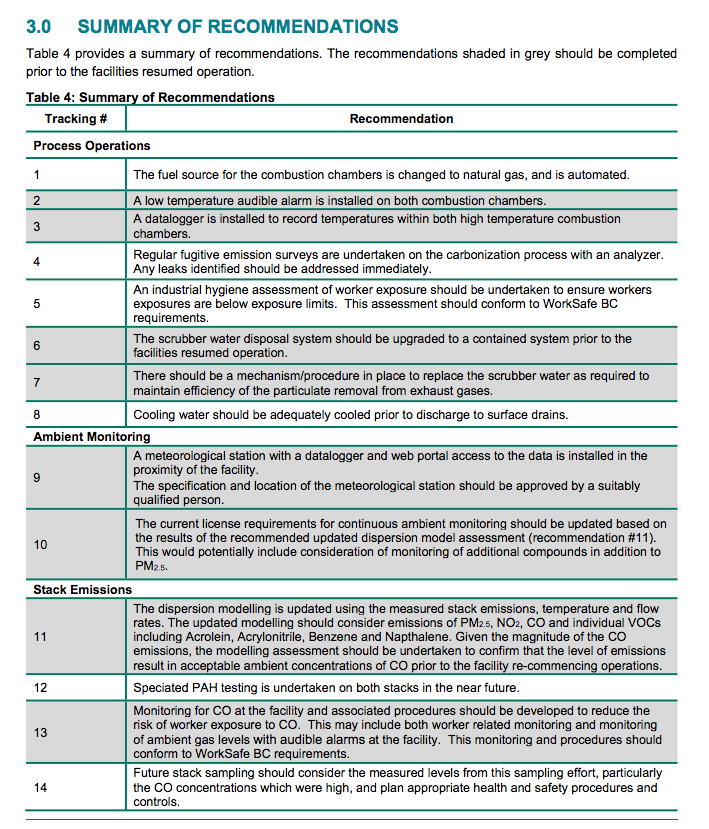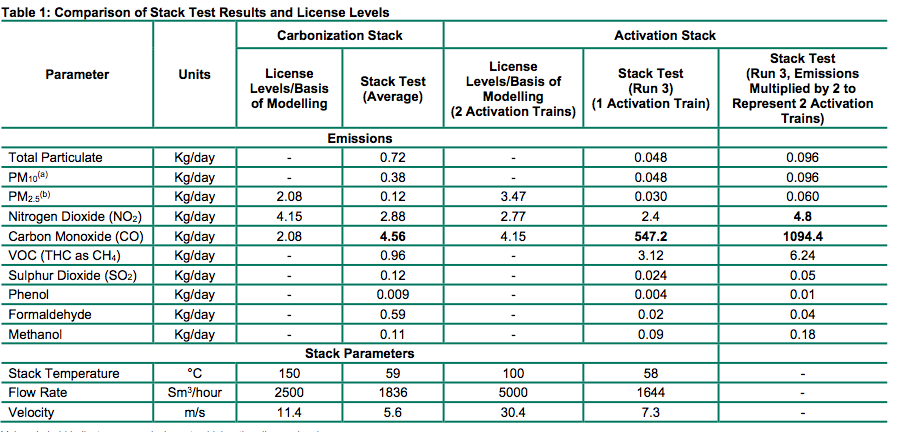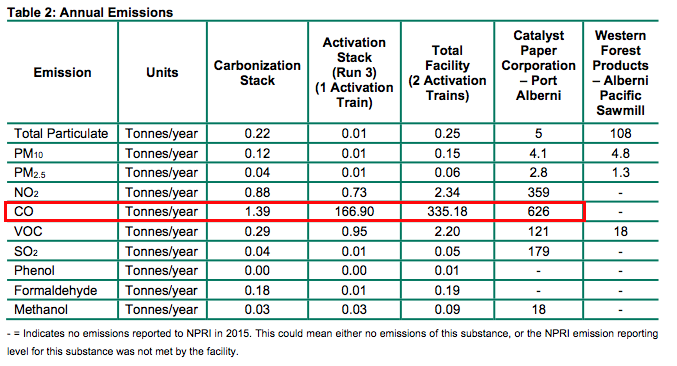(Updated Dec 21)
Subsequent the City of Port Alberni has released a statement on the report. Â Here is the City of Port Alberni’s statement.
Earlier this week, the Port Alberni Port Authority publically released the evaluation of operations and emissions at the Cantimber Biotech facility. The evaluation was conducted by Golder Associates, an independent consulting firm with expertise in emission measurement and controls and air quality permitting.
The report provides a thorough review of Cantimber’s operation with key findings and recommendations regarding the facility operation, emissions testing, air quality, and other regulatory considerations.
While the report outlines Cantimber’s general compliance with many of the provincial limits for emissions, there are air quality concerns identified that the City feels must be addressed before operations resume.
The City of Port Alberni’s paramount concern is for the health and welfare of the community. As such, the City is committed to working with the Port Alberni Port Authority, Golder Associates, Cantimber, the provincial health and environmental authorities, Hupacasath and Tseshaht First Nations, and the many regional partners to ensure the facility’s operation is safe and environmentally responsible. The City’s support of Cantimber operating in the community is contingent upon their being consistent with the high environmental standards that were committed to at the developmental stage of this venture.
Cantimber has expressed a strong commitment to fulfil the operational and emissions improvements identified in the report. The City remains confident in the opportunities to establish and grow an eco-industrial forest products cluster within the Alberni Valley as an economically and environmentally responsible component of our existing forest-based economy.
As the regulatory authority, the Port Alberni Port Authority(link is external) will be providing further information regarding the operational status and progress of Cantimber in addressing the report’s recommendations.
I in general agree with the City’s statement and their direction on this particularly the expectation that CanTimber operate ‘contingent upon their being consistent with the high environmental standards that were committed to’.
However, one thing the statement does not address is the water treatment and disposal issues that were identified in the report. Â As such, I have sent the following letter to City Staff and Council on the topic:
I think the statement is good however, I am concerned by the details in the report of disposal of the scrubbed water. What is in the water (which wasn’t part of Golder mandate)? How is it being transported (plastic containers? Then?), and where is it being disposed of? Â I am concerned by the potential noted in the report of that solution overflowing during strong rain events. What happens in that event? What are the consequences and actions? And finally, I am concerned about the cooling water, even though it should be “clean”, simply being sent down the drain. Â These all strike me as both City (sewer or waste disposal through acrd) and DFO items.I would like to please request that these issues be brought up with DFO to see if they have any concerns and some more detail provided by Cantimber or Golder on disposal, etc.Without these all being addressed fully it will be very hard to convince an already skeptical public.Thanks for your continued attention to this issue.Cheers,Chris
I hope the City will take this water issue seriously and bring DFO to the table. Â There was never any indication from the original reports that there would be any potential harm to the Harbour from the operation but I believe the water scrubber material and the hot water discharge put that at risk. Â Unfortunately the whole “no emissions” idea just hasn’t held up.
It should also be said that there were positives in the report, and it was not my intent to ignore those. Â The particulate and other air emissions were good and well within limits. Â It is the NO2, Carbon Monoxide, and the potential for PAHs that were a surprise and I am hopeful that CanTimber takes those concerns seriously and addresses all 21 of the recommendations fully before restarting operations.
Original Post
I have read the report on the emissions testing from engineers at Golder Associates.  These are my personal views on the report.  You can download the report here in PDF.  It is very good. I give credit to PAPA for bringing in Golder. They have produced a comprehensive and objective report.
The Bottomline
I was very hopeful for this facility and believed it could be a new way forward for our industry, but what I have read leads me to believe that at the very least this facility may not be viable in its current location, and at worst it may not be viable at all. Â They have much work to do before I would be comfortable with them restarting operations.
This report raises serious concerns on both the air and water emissions. Carbon Monoxide, Nitrogen Dioxide and PAHs were all identified as areas of concern and the water emissions from the scrubbers and cooling equipment are also issues.  The report indicates emissions modelling, ie. what we expected from the stacks and how it would behave, done for the 2015 Levalton report was “not considered to be representative of the facility”.  Carbon Monoxide levels were two hundred and fifty times higher than the licensed limits which is of similar magnitude as an operation the size of Catalyst Paper.
I believe these issues will need input from the Department of Fisheries and Oceans (who has not been involved to this point) and the Provincial Ministry of Environment.  Had this report been provided in place of the Levalton report I personally would not have supported this operation.
It is very far from “emissions free”.
There are major actions that need to be taken by CanTimber in order to ensure this facility is safe and can be properly monitored for their workers, for the neighbourhood, and for the air and marine environment.  Currently, I can’t realistically support it being operated at its waterfront Harbour location.
The Concerns and Recommendations
First, there are 21 recommendations in total.  There are 11 recommendations (shaded in grey) that “should be completed prior to the facilities resumed operation”.

 Some are relatively simple like installing permanent monitoring and alarm systems for temperatures and air quality.  Others are much more involved like upgrading the water disposal system to be a contained system that is regularly and safely emptied.
Some are relatively simple like installing permanent monitoring and alarm systems for temperatures and air quality.  Others are much more involved like upgrading the water disposal system to be a contained system that is regularly and safely emptied.
I will go through each of the 11 immediate concerns in order of what I think is most important, though they really should be all taken together and the final recommendation #21 speaks directly to that point.
RECOMMENDATION #10, 11 and 13
….updated modelling should consider emissions of PM2.5, NO2, CO and individual VOCs including Acrolein, Acrylonitrile, Benzene and Napthalene.
…GIven the magnitude of the CO emissions, the modelling assessment should be undertaken to confirm that the level of emissions result in acceptable ambient concentrations of CO prior to the facility re-commencing operations.
Monitoring for CO at the facility and associated procedures should be developed to reduce the risk of worker exposure to CO….
These are the most serious deficiencies, and recommendations, of all of them and it has to do with the emissions from the stacks.
Table 1 provides a summary of the stack test results. A comparison is provided against the emission rates used as the basis of the dispersion modelling assessment undertaken by Levelton (Levelton 2015).
The numbers on the left hand most column are what we expected based on the modelling reports the City and PAPA were provided prior to Cantimber starting up. Â CanTimber then agreed to adhere to those numbers (4.15 for Nitrogen Dioxide and 2.08 for Carbon Monoxide).
The Golder engineers bolded the areas of concern in the table.  Most of the emissions are well within limits but there are two, the Nitrogen Dioxide (NO2) and the Carbon Monoxide (CO) that are beyond the limits.  Nitrogen Dioxide is estimated to be double the agreed emissions and Carbon Monoxide more than 250x the agreed standard.
That level of emissions puts the small Cantimber Facility at the same general level as Catalyst Paper. Which Golder illustrates fully in the table below:
That amount of Carbon Monoxide emissions from such a small facility is shocking.
This is also concerning:
Measured stack temperatures are significantly lower than those used as the basis of the dispersion modelling (Levelton 2015). The lower temperatures will result in less thermal buoyancy, and therefore poorer dispersion of stack emissions.
Measured volumetric flow rates, and consequently stack gas velocities are lower than those used as the basis for the dispersion modelling (Levelton 2015).
You can see the flow rates and velocity in the first table above. Â The numbers on the far left column should be lower than the numbers on the far right. Â Unfortunately, they are not.
These factors together mean that all of that Carbon Monoxide is being emitted into the air and it is not dispersing very well. Â Golder identified it as a potential safety hazard for workers onsite. Â I would also be worried that it may be a hazard for neighbours including residents and WFP workers as this is a significant new source of Carbon Monoxide in the area.
I personally would never have given my support to a project with those levels of emissions in that location.
Furthermore:
Naphthalene, a polyaromatic hydrocarbon (PAH) was detected within both the carbonization and activation stacks. This was the only PAH compound currently included in the stack test. Based on the presence of naphthalene, stack testing of speciated PAH’s is recommended in the future.
These are potentially harmful emissions.  PAHs are nasty compounds.  These were also not considered a concern based on the previous reports so Golder has recommended that new assessments be done with those in mind.
It is recommended that the modelling assessment is updated for PM2.5, NO2, and CO, and additionally the modelling is used to assess the off-site concentrations of individual VOCs detected, including Acrolein, Acrylonitrile, Benzene and Napthalene.
Again, I would not have been as supportive of a project that produced these toxic chemicals and the fact the previous reports had no mention of even the possibility of some of these compounds is very disturbing.
RECOMMENDATION #6 AND #7:
“The scrubber water disposal system should be upgraded to a contained system prior to the facilities resumed operation. “
AND
“There should be a mechanism/procedure in place to replace the scrubber water as required to maintain efficiency of the particulate removal from exhaust gases.”
This scrubber water, which is in an open-to-the air vessel where the water is collected and evaporates will contain potentially harmful emissions (tars, acids, PAHs etc) from the stack gases. Â In a heavy rain event, this vessel could conceivably overflow. Â It is imperative that this water be removed in an efficient and safe way.
“The containment may not be adequate, particularly during periods of significant rainfall. During the evaporation, any water soluble organic compounds collected by the scrubbers have the potential to be re-emitted to the atmosphere.
During the site visit, an upgrade to the scrubber water system was discussed which includes capturing scrubber sump discharges within plastic containers, and subsequent removal off site for disposal. It is Golder’s understanding that these upgrades are currently in process and will be in place prior to the re-start of operations. “
I am not convinced that removing the water scrubber discharge in ‘plastic containers’ is very efficient or reliable.
This is also potentially a fishery concern if there is a chance that the system could overflow during heavy rainfall events.
Speaking of fisheries, Recommendation #8:
Cooling water should be adequately cooled prior to discharge to surface drains.
This is *not* a recommendation that is suggested to be complete before restart. Â However, here is what is stated from the report during the testing:
“Cooling water discharges were identified during the facility operation. The cooling water is non-contact water that is not in direct contact with the process gases.”
The temperature of the water discharge from the carbonization process “was estimated to be 50-70 °C” and  “was discharged to a surface water drain.”  The temperature from the water discharge from the activation process “was estimated to be 30-40 °C” and “was discharged to a surface water drain (Photograph 1). “
This should be simply city water that is being brought into the facility for cooling purposes only and not have anything added to it so it should be safe, but Golder was not asked to test this water and to my knowledge the Department of Fisheries was not contacted to ensure any discharges into the Marine environment is safe.
In my opinion, DFO should be brought into this process to sign off on the impact to the Harbour from both a potential spill of the water scrubber effluent and from this hot water discharge.  We should also hear from the Provincial Ministry of Environment on what is in the scrubber discharge and where it is being taken.  This would be standard for any industrial operation like Catalyst or Western Forest Products.  The City of Port Alberni may also have a responsibility to provide a sewer hookup for the facility.
Recommendation #2 and #3:
“A low temperature audible alarm is installed on both combustion chambers.”
and
“A datalogger is installed to record temperatures within both high temperature combustion chambers.”
The report states:
“To keep the combustion chambers temperature above 875 °C charcoal was added manually, approximately twice an hour. The timing of the charcoal addition was entirely dependent on the chamber temperature, and was therefore not added on a regular time basis (e.g., every 30 minutes). The temperature in the chamber relied on the operator visually monitoring the temperature read out, and acting to add more charcoal when the temperature decreased close to 875 °C.”
This strikes me as a surprisingly ‘hands on’ and inefficient approach. Â A high operating temperature is critical to ensuring emissions are kept to a minimum. This labour intensive approach makes that much more difficult. Â Golder recognized this as well as their Recommendation #1Â :Â “The fuel source for the combustion chambers is changed to natural gas, and is automated.” speaks directly to that. Â I am a little surprised that Golder did not recommend that that change over to natural gas be done before the system is restarted because this is also a concern that was raised before both by the Air Quality Council (by the Provincial Ministry of Environment) and by the general public.
There are also Worksafe BC concerns around emissions from leaks that were detected from the carbonization equipment itself and to protect the workers in that immediate vicinity.
“During the monitoring a leak was detected near the fire door of eastern furnace #4, which was traced to the nearby syngas valve. Concentrations at the leak location were detected up to 40 ppm. A temporary seal was made to the leak at the time it was detected. Concentrations at the other syngas valves ranged from 200 ppb to 15 ppm.”
Recommendations 4 and 5 address those concerns as there were leaks detected in the equipment during the testing. Â They recommend regular testing be done while it is in operation to identify any leaks so they can be resolved immediately and workers are not exposed to harmful emissions and are aware of exposure limits.
Recommendation #9
A meteorological station with a datalogger and web portal access to the data is installed in the proximity of the facility.
The specification and location of the meteorological station should be approved by a suitably qualified person.
There is a serious problem with the assumptions made because the weather at the facility is not the same at the nearest reliable weather station on Alberni Elementary (run by the BC Ministry of Environment)
Given the significant difference in wind pattern between the Cantimber and elementary school station locations, the meteorological data from the elementary school location is not considered to be representative of the wind pattern at the Cantimber facility. Therefore it is recommended that a meteorological station is installed in the vicinity of the facility. This will provide information to use in the investigation of complaints and interpretation of ambient monitoring data. The specification and location of the meteorological station should be approved by a suitably qualified person.
This means that because the modelling done for dispersion of air pollutants for the 2015 report relied on the Alberni Elementary station, it would not match the real world because the wind is so different along the Harbour. Â (As anyone in Port Alberni would know).
So I (and the City) made a decision to support the facility based on potentially incorrect data.
This would be an excellent argument for Environment Canada to re-install a meteorological station on the Somass River which should be much more representative of the Harbour, and of the City in general.
RECOMMENDATION #20
Inclusion of a condition in the permit to avoid saltwater contact with the wood chip feedstock.
Golder said:
The permit should include restrictions around the source of wood chips to ensure they are not in contact with saltwater, as this could potentially result in air emissions of dioxins and furans.
This was a surprising finding as I was always under the impression that none of the wood used in the facility was going to come from saltwater booms and so there was no worry about the wood being impregnated with salt which is well known to cause harmful emissions when it is burned, especially at low temperatures. Â I do wonder if the simple proximity of the wood to the Harbour may be enough to have them absorb some saltwater from mist and spray in the area.
RECOMMENDATION #21
The current license requirements for quarterly stack sampling should be updated based on the results of the recommended updated dispersion model assessment. As a minimum, quarterly stack testing for PM2.5, NO2 and CO is recommend during the first year of operation.
This means that Golder believes CanTimber needs to have its license requirements updated *after*Â more modelling based on an updated dispersion model. Â This would depend on all of the previous monitoring related recommendations being followed through on first.
Golder recommends that this all be done *before* CanTimber is allowed to resume operations.
Conclusion
I don’t know if all of these recommendations amount to a show stopper for CanTimber but one thing is for sure, I cannot support CanTimber restarting its operations until they have at least complied with the 11 recommendations from Golder.  And preferably they should have to comply with all  of them.
Realistically, they may not be able to comply with these recommendations and deal with the implications and still be sited on the Harbour Waterfront.
I do not believe at this time that this facility should be operating on the City of Port Alberni waterfront.




As a resident on 1st Avenue, I did report smelling acrid smoke from the stacks during the test period which were never addressed even after I spoke to PAPA. What can I do to have my voice as well as other residents voices heard?
Hi Lesley,
The best I can say I think is to contact PAPA again and include the City perhaps as well with a question on why your concerns were not addressed.
Send me an email if you like as well and we can chat about it there.
chrisale@gmail.com
So Mr. Michael Lui intentionally mislead the City of Port Alberni/PAPA and knew exactly what all of you wanted to hear. He REPEATEDLY said there would be zero emissions which is obviously a lie, Mr. Lui said it was just steam being emitted which after reading Golder Associates report that is not the case…with the health impacts to WFP employees/neighbours a class action law suit comes to mind. After being lied too Mr Lui cannot be trusted – Cantimber should not restart.